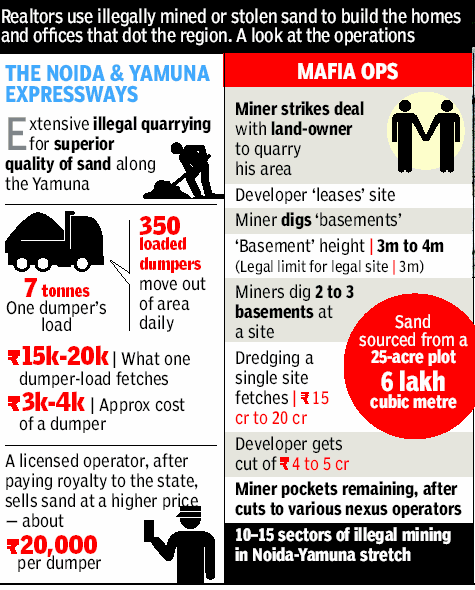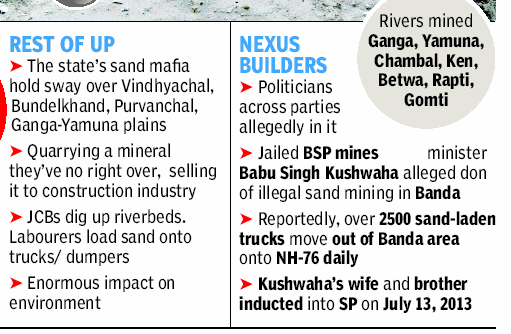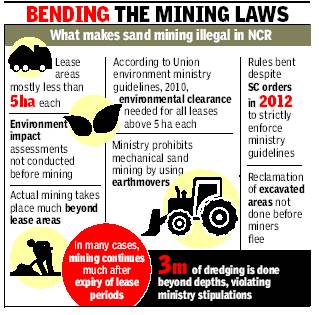Sand mining: India
This is a collection of articles archived for the excellence of their content. Readers will be able to edit existing articles and post new articles directly |
Contents |
Sand mining: India
Prior approval of the Union ministry of environment and forests is mandatory for all sand mining projects
Green Tribunal Says No Exception To Be Made On Size Of Project Area
Ayaskant Das TNN
The Times of India 2013/08/06
New Delhi: The National Green Tribunal reinforced [has reiterated?] the February 2012 Supreme Court order making it mandatory to take environment clearance for sand mining from the Union ministry of environment and forests, irrespective of the size of the project area. The order was based upon an application highlighting issues related to illegal sand mining in the Yamuna.
The NGT order, applicable across the country, states that the court restrains “any person, company or authority to carry out any mining activity or removal of sand from river beds anywhere in the country without obtaining environmental clearance from MoEF and state environment impact assessment authorities and licence from competent authorities.”
Deputy commissioners, superintendents of police and mining authorities of all states have been entrusted with the task of enforcing the ruling.
Before the 2012 Supreme Court order, environment impact assessments (EIA) were needed only for mining projects that were located in an area of 5 hectare or more. The law was subject to massive misuse as mining proposals were often officially shown as less than the given area though a much larger area was eventually plundered.
A five member Bench headed by NGT chairperson Swatanter Kumar said that mining sand without the necessary licences was a violation of the Environment Protection Act of 1986, Air (Prevention and Control of Pollution) Act, 1981 and Water (Prevention and Control of Pollution) act, 1974. “Besides violations of law, the mining activity is being carried out on a large scale, causing state revenue loss which may be running into lakhs of crores of rupees,” the court observed.
SAND PIT
NGT petition filed specifically on rampant sand mining in Noida
The petition alleges that majority of sand miners are operating without licences
Sand miners have no environmental clearances from the MoEF or the state government
Illegal dredging is causing large-scale revenue losses to the state exchequer
The illegal activity is threatening the flow of river as well as forests along the banks
The economics of illegal sand mining
Nagpal crackdown cost sand mafia 500cr
9L Tonnes Extracted In A Year, Monthly Turnover 100Cr: Sources
Vandana Keelor & Purusharth Aradhak TNN
The Times of India 2013/08/03
Noida/Greater Noida: The boom in construction activity in the NCR, coupled with the lack of alternatives to river sand, has made illegal sand mining a lucrative business here. Trucks illegally enter the river bed, and sand miners have the tacit support of political parties. Scores of dredgers can be seen operating with impunity even as they manage to overcome officials like Durga Sakthi Nagpal, who are few and far between.
Conservative estimates by sources connected to the sand mafia put the quantity of sand illegally extracted in the past one year at nine lakh tonnes, which took about 1.27 lakh trips from Gautam Budh Nagar by bribing cops on the inter-state borders of Delhi, Haryana and UP. Sand has been smuggled mainly out of Noida and Greater Noida, including villages of Gulavli, Kambakspur, Jaganpur, Asgarpur, Afzalpur, Chaproli, Dankaur, Atta Gujaran, Gunpura, Faleda, Tekpur, Shergarh, Nangla Wajidpur, Mehndi and Gharbara.
Sources said 350 trucks or dumpers, including tractortrolleys were involved in the smuggling. “We used to pay Rs 50-100 per vehicle at checkpoints to cross over. Now, the monthly charges have been fixed and we get a free pass,” said a driver. As the returns are high, many trucks can be seen making several trips during the night while the PCR cops look on.
According to sources, Nagpal’s crackdown in the past few months has led to annual losses of Rs 500 crore for the smugglers. More checkpoints were mounted and touch action was being taken against smugglers. “Earlier, smugglers got away by paying a fine. Now, we seize the vehicle and register cases against the vehicle owner,” said a transport official.
If the administration’s estimates are to be believed, this business helps rake in Rs 100 crore in a month. A truckload of sand costs Rs 5,000-6,000, while a tractor-trolley can fetch Rs 2,000-3,000. Sources said during shortfall, a loaded dumper can allow the mafia to make Rs 25,000. The district is able to squeeze only Rs 1 crore as revenue despite intensive drives to clamp down on illegal sand mining. Revenue officials said over Rs 2 crore was recovered as fines in the past year, losses incurred by the revenue department are mounting. Without paying money to mafia, no realtor or mining contractor can start digging on a plot for real estate projects.
The sand mining operation works at several levels. On the top are members of the syndicate, which works as a bridge between the government and the mining mafia. Then there are several independent small-time players who can afford trucks, tractors and excavators, besides those who manage a network of independent operators. Those in the “business” say the unflagging demand for sand and the big money involved propels underhand operations, and at times, triggers attacks on those who complain to authorities. After the clampdown, there is a lull but the activity picks up as fast as it stops, said locals who have seen the plundering of the river bed.
A MURKY BUSINESS
250 to 350 truckloads of sand dredged illegally everyday
Nearly 500 crore worth of sand stolen from the riverbeds every year
Sand sold to real estate projects in Gautam Budh Nagar, Gurgaon, Ghaziabad, Delhi and Faridabad
A truckload of illegal sand costs about 5,000-6,000 while a tractor trolley comes for 2,000-3,000
When sand is in short supply, a dumper could cost up to 25,000
Mining is rampant in villages like Asgarpur, Nangla Wajidpur, Gulavli, Kambakshpur, Jaganpur, and on a nearly 10-km stretch running parallel to Noida-Greater Noida Expressway
Real estate and illegally mined sand
Real estate biz thrives on illegally mined sand


The Times of India 2 Aug 2013
Noida: Although an essential element in construction that determines the overall cost of a real estate project, sand in this region is all mined illegally. There are no licensed miners and there are areas where there’s a blanket ban on sand mining. Yet, all of Noida’s construction projects depend on stolen sand. The real estate industry mostly lends support to sand mining activities in the district.
Developers are always on the lookout for cheap sand. They’re provided this by a mafia network that digs deep into the riverbeds of Hindon and Yamuna in Gautam Budh Nagar. They have no permission, evade royalty and brazenly flout whatever norms exist.
The sand mafia sells the construction material in the range of Rs 6000-20,000 per dumper, depending on the quality of the sand. Trolley rates range between Rs 3,000 and 8,000 again based on quality. There are three gradations to sand, and Noida boasts the top grade.
For a truck of illegal sand, builders pay half the rate they would for a licensed truck-of-sand. “We depend upon vendors and suppliers. The cost of sand is around Rs 12-16 per cubic foot. If procured legally, project costs would shoot up by 10-15%. That’s why we opt for cheaper option,” said a leading developer. The mafia even delivers truckloads at the builder sites but neither government nor police bother to check on how the sand is procured.
Realtors say the mining, though illegal, boosts the ‘development’ engine. “Without this sand, construction would come to a grinding halt,” said a realtor. Another reluctantly concedes that without a regulatory and monitoring framework to dig out the sand, the rush to build factories, high-rises offices, schools and roads, may be taking a toll on the environment. Some are coming around to the view that policy and legal measures to control sand mining must be made more stringent and should be based on environmental concerns.
There are suggestions for replacing sand. “The need of the hour is to find substitutes for sand, such as concrete blocks instead of traditional brickwork, elimination of plaster, etc,” said a builder with several projects in the region.
Why Sand Mining Is Bad
Sand acts as an aquifer (holds water), carpet on river bottom Removing this layer leads to downstream erosion
It deepens the river, changes the channel bed
Ground water shortages main problem with river sand mining
The river system lowers, local groundwater is affected
Leads to water scarcities aggravating agriculture and local livelihoods
Direct loss of habitat, disturbances of river species, reduced light penetration, etc
Officers targeted by sand mining lobby
SHIFTING SANDS
Durga Nagpal latest in list of officers targeted by sand mining lobby
The Times of India 2013/08/03
Jun 8, 2013 Himanshu Kumar transferred within 24 hours from post of divisional commissioner (Allahabad). He swung into action against illegal sand mafia in the district’s Shankergarh area. Kumar took over on June 7, transferred on June 8. PIL filed in court
Jun 15, 2013 Allahabad HC ask UP govt to show records/ reasons for Kumar’s transfer. Court notes he was shifted as he took up complaint against sand mafia. Reportedly, his replacement an officer recommended by the sand miner lobby
May 16, 2013 Sand mafia brutally assault UP officials, including 2 cops, at Shamli, about 100 km from Delhi, try to run them over with tractor. The team of revenue officials & cops were checking on illegal mining reported in the area on Yamuna’s banks
Mar 2, 2013 Kunda circle officer Dy SP Ziaul-Haq killed in mob violence in village Kunda. Probe still on. Haq had taken on sand-miners’ lobby, conducted raid on January 18 on illegal activity at Gotni Ghat. On the day Haq & SDM AK Srivastava seized a JCB used for digging sand, intercepted three trucks and eight tractor-trolleys laden with sand. Most contractors in region flaunt allegiance to Pratapgarh’s Raja Bhaiya, let off the hook in this case by CBI
Mar 2012 SP Pratibha Ambedkar transferred from Kaushambi after she ordered registration of cases against officials involved in rampant sand mining in the Yamuna.
10 projects given green clearance since 2012
Neha Lalchandani & Ayaskant Das TNN
The Times of India 2013/08/04
New Delhi: The Supreme Court passed an order in February 2012 stating that all mining projects spread over an area of 5 hectares or more needed an environment clearance (EC). The ministry of environment and forest’s website shows that between Delhi, Haryana and Uttar Pradesh, ECs have been granted to only 10 projects since 2012, all of which are located in UP’s Saharanpur district.
Meanwhile, sand mining in the Yamuna river bed is rampant across all three states. “Mining might not be taking place in the capital but it is rampant both upstream of Wazirabad and downstream of Okhla, including NCR. All of it is illegal as nobody has applied for an EC,” said Manoj Mishra of Yamuna Jiye Abhiyaan.
The SC ruling came after a panel, formed by the Union environment ministry in 2010 to study the environmental impact of mining minor minerals, had laid down guidelines to be implemented by state governments.
The Times of India visited some spots from where reports of mining were received. At all such places, mining had been suspended since the past few days. Villagers said it was probably an outcome of the recent raids. At one point in Noida, tyre marks of trucks were visible along the banks, where large pits showed that sand had been recently scooped out.
There have been a few occasions when local administration has clamped down on mining but very often, because the river flows between two states, they cannot take action. “We need the states to work collectively. In 2009, we caught people mining sand ahead of Wazirabad which had changed the course of the Yamuna. Since it was on the UP side, we informed the UP administration but no action was taken. We had to wait for the culprits to move into Delhi before we could apprehend them,” said a government official.
Since most of the mining takes place on the outskirts of the city, sources claim that police and administration do not pay much attention to it. An increase in construction activity in NCR has also spurred a massive demand for sand, leading to an increase in mining.
Himanshu Thakkar, coordinator of South Asia Network on Dams, Rivers and People, says there is a huge loophole in the policy mechanism to control sand mining. “The court set a limit of 5 hectares but this rule is often flouted. People will have several patches of 4.9 hectares. An assessment of what is sustainable mining for each river needs to be done since the nature of each river is different. The regulator should then monitor the total area under mining for each river to ensure that it is collectively not more than the sustainable limit and involve local communities in this effort,” he said.
Thakkar says unchecked mining can spell doom for a river. “It can potentially change the course of the river. Sand forms a suitable bed for groundwater recharge and should not be removed. Boulders, which are also mined along with sand, provide a suitable habitat for the river’s biodiversity. Mining increases the chances of erosion and makes the river prone to disasters. The river carries silt during monsoon which makes the river bed extremely fertile and suitable for crop cultivation. Removal of sand takes away this advantage,” he said.
illegal mining has also destroyed the natural habitat of organisms like birds and also lowered the water table. Breeding and migration patterns of fishes have been affected downstream.
Sept 22, 2011 FIR lodged by Kaushambi SP Pratibha Ambedkar against addtnl zilla panchayat officer who falsely claimed private ghat as govtowned for illegal activities
